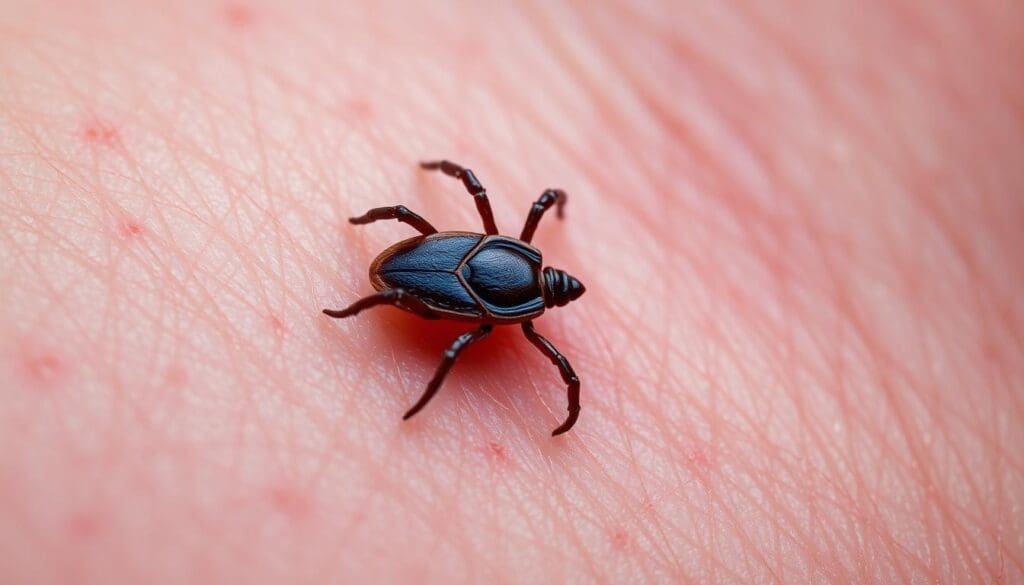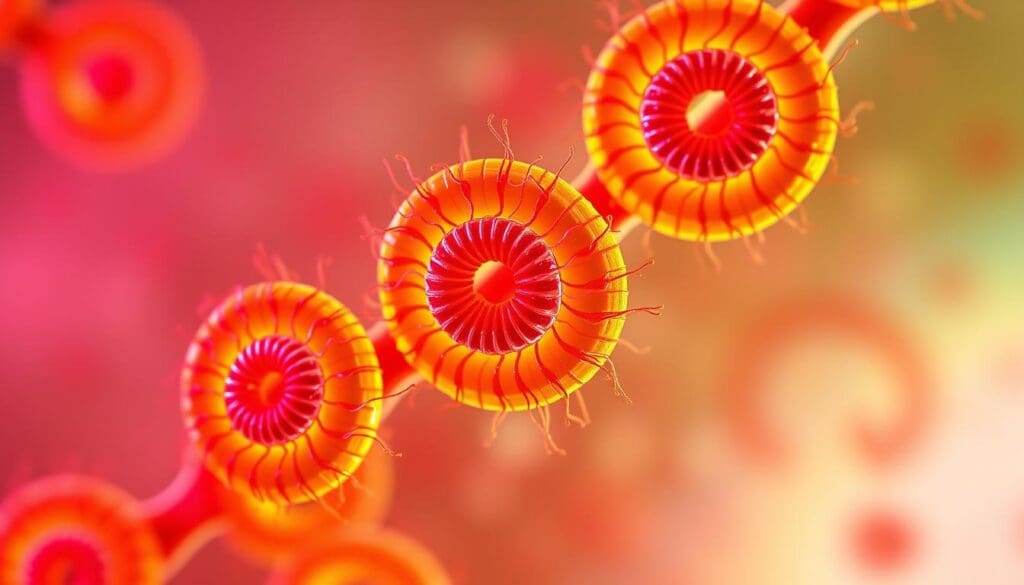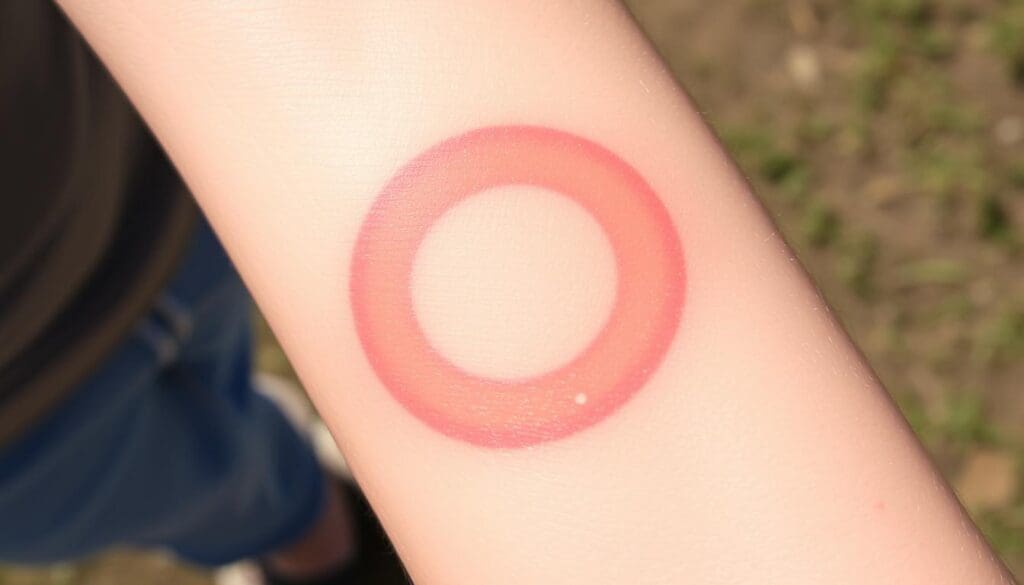
Understanding Lyme Disease: Symptoms and Treatment
Did you know that an estimated 476,000 people in the United States are diagnosed with Lyme disease each year? This number is much higher than the 30,000 cases officially reported. It shows how common this tick-borne illness is, especially in certain areas.
Lyme disease usually happens between April and October, when ticks are most active. It’s important to know that symptoms can show up 3 to 30 days after a tick bite. Early treatment with antibiotics can help you fully recover. But, some people may still have lingering effects known as Post-Treatment Lyme Disease Syndrome (PTLDS).
Learning more about Lyme disease will help you understand its stages, symptoms, and treatments. You’ll also find out how to prevent it and the latest research to fight this bacterial infection.
What is Lyme Disease?

Lyme disease is caused by borrelia bacteria. It spreads through tick bites. The name comes from Lyme, Connecticut, where it was first found in 1975. If you’re in wooded or grassy areas, you might be at risk.
Definition and Cause
Lyme disease is a bacterial infection. The main bacteria is called Borrelia burgdorferi. These bacteria live in ticks. When an infected tick bites you, it can pass the bacteria into your blood.
Transmission through Tick Bites
Deer ticks, or black-legged ticks, carry Lyme disease. They’re tiny, about the size of a poppy seed. To get infected, an infected tick must attach to your skin for 36 to 48 hours. The longer it stays, the higher your risk.
Geographical Distribution
Lyme disease is common in the U.S., especially in the Northeast, Mid-Atlantic, and upper Midwest. It’s also found in Europe and Asia. The risk is higher in wooded or grassy areas. In the U.S., Delaware has black-legged ticks in every county, showing how widespread the disease is.
Recognizing Lyme Disease Symptoms

Lyme disease often starts with subtle signs that can be easy to miss. The early symptoms usually appear within 3 to 30 days after a tick bite. You might experience flu-like symptoms such as fever, chills, headache, and fatigue. These can be accompanied by muscle and joint aches, making you feel under the weather.
The most telltale sign of Lyme disease is the distinctive rash called erythema migrans. This Lyme disease rash typically looks like a bull’s-eye, with a red center surrounded by a clear area and an outer red ring. It can grow to be larger than 2 inches in diameter and usually lasts for more than a few days. The rash might feel warm to the touch but is rarely itchy or painful.
It’s crucial to note that not everyone develops this characteristic rash. In fact, some people might not show any early symptoms at all. If you’ve been in tick-prone areas and experience unexplained fatigue or new headaches, it’s wise to consult a healthcare professional. Remember, Lyme disease is most common in the upper Midwest and northeastern United States, with peak risk from May to August. However, infection can occur year-round, especially on the west coast.
The Three Stages of Lyme Disease
Lyme disease goes through three stages, each with its own symptoms. Knowing these stages is key to catching it early and treating it right. Let’s look at how the disease starts and its long-term effects.
Early Localized Stage
The first stage happens a few days to weeks after a tick bite. You might see a bull’s-eye rash called erythema migrans at the bite spot. This rash shows up in up to 8 out of 10 cases.
Other signs include fever, tiredness, and body aches. Getting treatment early is very important to stop the disease from getting worse. Preventing it from advancing is key.
Early Disseminated Stage
If not treated, the disease spreads through your body. This stage starts 3 to 10 weeks after the tick bite. You might see more rashes, face paralysis, and heart issues.
Neurological symptoms like nerve pain can also show up. About 20% of people get to this stage, needing stronger treatment.
Late Disseminated Stage
The last stage starts 2 to 12 months after infection. Joint inflammation, especially in the knees, is common. Severe neurological symptoms can affect your focus and memory.
In rare cases, long-term heart problems can happen. Quick diagnosis and treatment are crucial to avoid this stage and lessen long-term damage.
Lyme Disease Diagnosis
Diagnosing Lyme disease can be tricky. Your doctor will look at your symptoms, ask about tick exposure, and run tests. The main tools for diagnosis are clinical evaluation and antibody tests. These tests check for your body’s response to the infection, but they’re not perfect.
Antibody tests may give false negatives in the first few weeks. They work best after 4-6 weeks when your body has had time to make antibodies. If you’re tested too early, you might need to come back for another test later. Your doctor will consider other illnesses with similar symptoms too.
Diagnostic testing for Lyme disease is complex. Lyme disease can overlap with other tick-borne, making diagnosis even harder. Up to 10% of Lyme patients also have anaplasmosis. Other less common co-infections include babesiosis and Powassan virus disease.
Remember, early treatment leads to better outcomes. If you suspect Lyme disease, don’t wait to see your doctor. Prompt clinical evaluation and appropriate diagnostic testing can make a big difference in your recovery.
Treatment Options for Lyme Disease
Lyme disease treatment often involves antibiotics. Doctors usually give doxycycline, amoxicillin, or cefuroxime first. For serious cases, like neurologic Lyme, they might use ceftriaxone given through an IV.
Managing Persistent Symptoms
Some people still have symptoms after antibiotics. This is called post-treatment Lyme disease syndrome. Doctors might suggest non-antibiotic treatments then. These can include gabapentin or duloxetine for pain, and bupropion or modafinil for fatigue.
Alternative Treatments
Some people also try alternative treatments. Mindfulness meditation, yoga, and acupuncture can help with pain and energy. Supplements like lemon balm and melatonin can improve sleep. But, these don’t replace medical care for Lyme disease.
Preventing Tick Bites and Lyme Disease
Preventing tick bites is key to fighting Lyme disease. In the U.S., over 300,000 new cases are reported each year. To protect yourself, use EPA-registered insect repellents with DEET, picaridin, or oil of lemon eucalyptus. These products keep ticks and other insects at bay.
Wearing protective clothing is also important. Wear long sleeves and pants outside, and tuck pants into socks. Treat your clothes with permethrin for long-lasting protection. This simple action can greatly lower your risk of tick bites.
It’s crucial to do regular tick checks after being outside. Deer ticks, which spread Lyme disease, are tiny. Check your body, especially hidden spots like the scalp, armpits, and groin. Removing a tick within 24 hours can significantly lower Lyme disease risk.
Other steps include showering within two hours of coming inside and washing clothes in hot water. These actions help remove ticks and lower your risk. By following these tips, you can enjoy the outdoors safely. Learning about tick-borne illnesses is also important for quick detection and treatment.
Complications and Long-Term Effects
Lyme disease can cause long-term problems that affect your life a lot. Many people have chronic symptoms even after treatment. These can include severe fatigue, pain, brain issues, and trouble sleeping.
Post-Treatment Lyme Disease Syndrome (PTLDS)
PTLDS affects 5 to 30 percent of Lyme disease patients. In one study, half of the participants reported severe fatigue. Others had severe pain and brain problems. Researchers are working to identify biomarkers for better diagnosis and treatment.
Chronic Lyme Disease Controversy
The debate on chronic Lyme disease exists. Some evidence shows the bacteria can stay after treatment. Celebrities like Shania Twain and Avril Lavigne have talked about their long-term Lyme disease struggles. If you test negative but still have symptoms, you might have another tick-borne illness or an autoimmune disorder.
Impact on Quality of Life
The long-term effects of Lyme disease can greatly affect your daily life. Pro golfer Jimmy Walker took 35 pills daily months after his diagnosis. Children are less likely to have chronic symptoms if treated quickly. With more ticks due to environmental changes, understanding Lyme disease’s long-term effects is key to a good quality of life.
Dehydration Due To Lyme Disease
Lyme disease can cause dehydration, leading to discomfort and health risks. Many patients feel very thirsty, drinking up to twenty glasses of water a day. This symptom is often overlooked or misdiagnosed, as it’s not commonly linked to Lyme disease.
Understanding Dehydration in Lyme Disease
Dehydration in Lyme disease patients comes from different sources. Fever, a common symptom, makes patients lose more fluids. Some try to fight off low blood sugar by drinking more sugar, which can lead to blood sugar spikes and more thirst.
It’s important to stay hydrated and keep electrolyte levels balanced.
IV Therapy for Lyme Disease Symptom
IV treatment is seen as a possible way to manage Lyme disease symptoms, including dehydration. This method gives fluids and nutrients straight into the bloodstream, avoiding the digestive system. IV hydration therapy can quickly replace lost fluids and electrolytes, helping to ease severe dehydration and manage symptoms.
Even though IV therapy looks promising, its true effectiveness for Lyme disease is still being studied. Patients should work with their healthcare providers to create a treatment plan. This plan might include IV therapy along with other proven methods for managing symptoms and recovery.
Current Research and Future Directions
Lyme disease research is moving fast. Scientists are finding new ways to prevent, diagnose, and treat it. They aim to tackle the tough challenges this illness presents.
Vaccine Development
Researchers are working hard on a Lyme disease vaccine. This could greatly lower your chance of getting sick. They’re focusing on the bacteria and ticks that spread it, hoping to create a strong shield against it.
Improved Diagnostic Tests
There’s a big push for better Lyme disease tests. New tests are being made to spot the illness sooner and more accurately. This could mean faster treatment and better health for those affected. In 2022, the CDC reported 62,551 Lyme disease cases, showing the urgent need for better tests.
Novel Treatment Approaches
Scientists are looking into new ways to treat Lyme disease. They want to help those with ongoing symptoms and prevent long-term problems. Research shows 10-20% of patients still have symptoms after treatment. This has led to studies on new therapies and alternative methods to manage the disease better.
The outlook for Lyme disease management is hopeful. With ongoing research in vaccines, better tests, and new treatments, you can expect more effective prevention and care soon.
Conclusion
Lyme disease awareness is key because it’s a serious health threat. The CDC says there are about 300,000 cases in the US each year. In Canada, cases jumped six times from 2009 to 2015. This shows how important it is to prevent and treat tick-borne illnesses early.
Studies show that starting antibiotics quickly can stop the disease from getting worse. Without quick treatment, 10-35% of people might not get better. This shows how crucial it is to catch and treat Lyme disease fast. Doctors are still figuring out the best treatment, needing more research and trials.
As tick-borne infections become more common, especially in central and eastern Canada, teaching people is more important than ever. Knowing the signs, how to prevent it, and treatment options can help keep you and your family safe. Remember, catching Lyme disease early and treating it quickly is the best way to manage it.
FAQ
What is Lyme disease?
Lyme disease is a bacterial infection spread by ticks. In North America, black-legged ticks are the main culprits. In Europe, castor bean ticks are responsible. It’s most common in the upper Midwest, northeastern, and mid-Atlantic states of the US, as well as in Europe and parts of Canada.
How is Lyme disease transmitted?
Lyme disease spreads through tick bites. Ticks get the bacteria from animals and pass it to humans. The risk is higher in wooded or grassy areas, especially in spring, summer, and fall. Ticks need to be attached for over 24 hours to infect humans.
What are the symptoms of Lyme disease?
Early signs of Lyme disease appear 3 to 30 days after a tick bite. They include a bull’s-eye rash, fever, chills, headache, and fatigue. Muscle and joint aches, swollen lymph nodes, facial paralysis, heart problems, nerve pain, and arthritis can also occur.
How is Lyme disease diagnosed?
Doctors diagnose Lyme disease by looking at symptoms, tick exposure, and lab tests. These tests check for antibodies to the bacteria. They also consider other illnesses that might have similar symptoms.
How is Lyme disease treated?
Antibiotics treat Lyme disease. Early treatment helps ensure a quick recovery. Some people may still have symptoms after treatment, known as post-treatment Lyme disease syndrome (PTLDS). Managing these symptoms is key.
How can I prevent Lyme disease?
To prevent Lyme disease, avoid tick areas, use insect repellents, and treat clothes with permethrin. Wear protective clothing and check for ticks regularly. Remove attached ticks quickly and shower and wash clothes at high temperatures after being outdoors.
What are the long-term effects of Lyme disease?
Some people experience long-term effects like joint pain, cognitive issues, and fatigue. PTLDS can greatly affect quality of life. The cause of PTLDS is not fully understood. The debate over chronic Lyme disease continues.
Can Lyme disease cause dehydration?
Yes, Lyme disease can cause dehydration due to fever and inflammation. IV therapy may help with severe dehydration. However, its effectiveness for Lyme symptoms is not proven.
What is the current research focus for Lyme disease?
Research aims to improve prevention, like vaccines, and early detection tests. It also explores new treatments for persistent symptoms and long-term complications.
Source Links
- https://medlineplus.gov/lymedisease.html
- https://www.hopkinsmedicine.org/health/conditions-and-diseases/lyme-disease/ticks-and-lyme-disease
- https://www.webmd.com/rheumatoid-arthritis/arthritis-lyme-disease
- https://www.dhss.delaware.gov/dhss/dph/epi/lyme.html
- https://www.nhs.uk/conditions/lyme-disease/
- https://www.mayoclinic.org/diseases-conditions/lyme-disease/symptoms-causes/syc-20374651
- https://www.hopkinslyme.org/lyme-disease/lyme-disease-signs-symptoms/
- https://medlineplus.gov/ency/article/001319.htm
- https://www.ncbi.nlm.nih.gov/books/NBK431066/
- https://www.healthline.com/health/lyme-disease
- https://www.cdc.gov/lyme/diagnosis-testing/index.html
- https://www.mayoclinic.org/diseases-conditions/lyme-disease/diagnosis-treatment/drc-20374655
- https://www.columbia-lyme.org/treatment-options
- https://www.uptodate.com/contents/lyme-disease-treatment-beyond-the-basics/print
- https://www.hopkinslyme.org/lyme-education/5-tips-for-preventing-tick-bites-and-lyme-disease/
- https://www.fda.gov/consumers/consumer-updates/ticks-and-lyme-disease-symptoms-treatment-and-prevention
- https://www.cdc.gov/ticks/prevention/index.html
- https://www.hopkinsmedicine.org/news/newsroom/news-releases/2018/02/study-shows-evidence-of-severe-and-lingering-symptoms-in-some-after-treatment-for-lyme-disease
- https://www.healthline.com/health-news/painful-debilitating-long-term-effects-of-lyme-disease
- https://www.ncbi.nlm.nih.gov/pmc/articles/PMC7052487/
- https://www.cdc.gov/lyme/signs-symptoms/index.html
- https://www.globallymealliance.org/blog/excessive-thirst-and-lyme-disease
- https://www.niaid.nih.gov/sites/default/files/NIAIDLymeReport.pdf
- https://www.ncbi.nlm.nih.gov/pmc/articles/PMC8416313/
- https://www.cdc.gov/mmwr/volumes/73/wr/mm7306a1.htm
- https://www.ncbi.nlm.nih.gov/pmc/articles/PMC7551198/
- https://www.ncbi.nlm.nih.gov/pmc/articles/PMC5864449/
